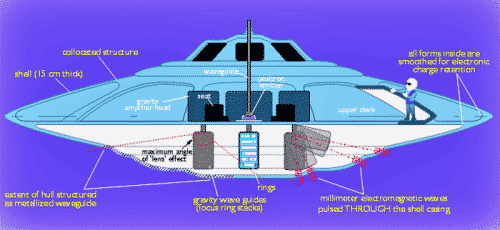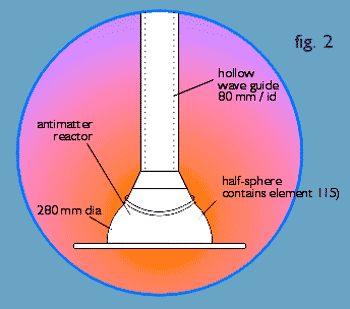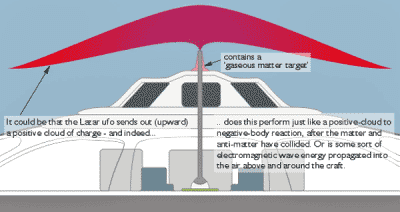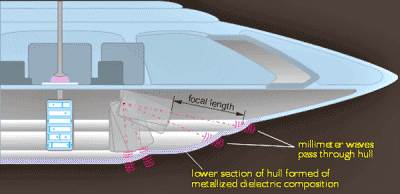The Intelligent and Practical Physics of UFO Propulsion
Number 1 – Lazars Gravity Generating UFO the S4 (Eyepod)
Bob Lazar’s Gravity Generators

The following is the rubber sheet explanation of space-time manipulation by Bob Lazar.
“Assuming they’re in space, they will focus the three gravity generators on the point they want to go to.
Now, to give an analogy: If you take a thin rubber sheet, say, lay it on a table and put thumbtacks in each corner, then
take a big stone and set it on one end of the rubber sheet and say that’s your spacecraft, you pick out a point that you want to go to – which could be anywhere on the rubber sheet – pinch that point with your fingers and pull it all the way up to the craft.
That’s how it focuses and pulls that point to it. When you then shut off the gravity generator[s], the stone (or spacecraft) follows that stretched rubber back to its point.
There’s no linear travel through space; it actually bends space and time and follows space as it retracts. In the first mode of travel – around the surface of a planet – they essentially balance on the gravitational field that the gravity generators put out, and they can ride a “wave”, like a cork does in the ocean.*
In that mode they’re very unstable and are affected by the weather.
In the other mode of travel – where they can travel vast distances – they can’t really do that in a strong gravitational field like Earth, because to do that, first of all, they need to tilt on their side, usually out in space, then they can focus on the point they need to with the gravity generators and move on.
If you can picture space as a fabric, and the speed of light is your limit, it’ll take you so long, even at the speed of light, to get from point A to point B. You can’t exceed it – not in this universe anyway.
Should there be other parallel universes, maybe the laws are different, but anyone that’s here has to abide by those rules.“

“Inside the reactor, Element 115 is bombarded with a proton which plugs into the nucleus
of the 115 atom and becomes Element 116, which immediately decays and releases,
or radiates, small amounts of antimatter.
The antimatter is released into a tuned tube which keeps it from reacting with the matter
that surrounds it. It is then directed toward a gaseous matter target at the end of the tube.
The matter and antimatter collide and annihilate, totally converting to energy.
The heat from this reaction is converted into electrical energy in a near 100% efficient thermoelectric generator…”
Element 115 is a superheavy element found probably on a planet of a binary star system.
Supposedly the craft uses 223 grams, cut to a triangular shape, within the reactor structure,
[in a cloud chamber it was shown to alter, by gravitational forces, the paths of released alpha particles].
The thing about Lazar’s central tube assembly, which he doesn’t make mention of, is that it surely must be used as a circular cross-section waveguide for high-frequency waves.
From his graphics it looks like an 8cm tube and that would relate to an electromagnetic wave in the microwave region (especially if the tube terminated at the top at a smaller diameter).
And whatever the target is, hitting it with these microwaves most probably causes the molecules and atoms of the target ‘gases’ to resonate (as in electron spin resonance), the resonance then pulls the electrons up the energy bands and greatly increases their energy level.

If you look at the graphic you will see three sections of the bottom of the hull especially curved, and each of these curved sections because they are differently spaced from the wave generators have a different “focal length” (to use a photographic term), and because at different focal lengths the wave’s shape will be different as it enters the dielectric waveguide lens then the resultant wave produced by that lens-waveguide when that wave passes through it will also be different.
Couple to this the fact that for every different angle that the waves pass through the dielectric hull a different effect of refraction will occur to the wave.

Consider next that if this craft uses the two outer generators to focus their two microwave-beams at some finite point in the distance it would follow that to approach that same point in space the two beams will have traversed through a different thickness of the dielectric lens, and at a different angle, meaning that the two beams will be shaped slightly differently.
If, then, it can be controlled how the two waves are shaped then it will also be possible to control their constructive and destructive interference pattern – and hence the strength or weakness of the electric field at the area where the two beams approach each other.
And as you already know the stronger the electric field the stronger the repulsion – the stronger the acceleration.



 Creators of mankind
Creators of mankind Description of “Tall white aliens”
Description of “Tall white aliens” Where they came from?
Where they came from? About hostile civilizations
About hostile civilizations The war for the Earth
The war for the Earth “Tall white aliens” about eternal life
“Tall white aliens” about eternal life Video: “Nordic aliens”
Video: “Nordic aliens” Aliens
Aliens Alien encounters
Alien encounters The aliens base
The aliens base UFO
UFO Technology UFO
Technology UFO Underground civilization
Underground civilization Ancient alien artifacts
Ancient alien artifacts Military and UFO
Military and UFO Mysteries and hypotheses
Mysteries and hypotheses Scientific facts
Scientific facts


















